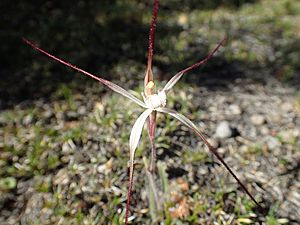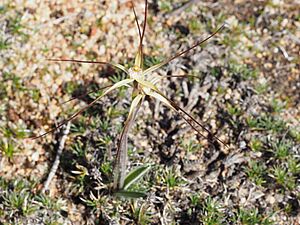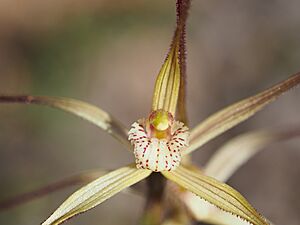Chameleon orchid facts for kids
Quick facts for kids Chameleon orchid |
|
|---|---|
 |
|
| Caladenia dimidia in Dragon Rocks Nature Reserve | |
| Scientific classification | |
| Genus: |
Caladenia
|
| Species: |
dimidia
|
| Synonyms | |
|
|
The chameleon orchid (Caladenia dimidia) is a special type of orchid. It grows only in the south-west part of Western Australia. This means it is endemic there, found nowhere else naturally.
This orchid has a single leaf that feels a bit hairy. It usually grows one or two flowers. These flowers can be yellow, cream, or even a bit pink. The chameleon orchid is quite varied in how it looks. It is similar to another orchid called the Joseph's spider orchid (C. polychroma). However, the chameleon orchid grows further north and has smaller flowers.
Contents
What Does the Chameleon Orchid Look Like?
The chameleon orchid is a plant that grows from an underground tuber. It is a perennial plant, meaning it lives for more than two years. It is also deciduous, so it loses its leaves at certain times. These orchids usually grow alone or in small groups.
Its Leaf
Each plant has one leaf that stands straight up. This leaf is thin and long, about 7 to 15 centimeters (3 to 6 inches) long. It is also quite narrow, only about 2 to 3 millimeters (0.08 to 0.12 inches) wide. The leaf is light green. You might see some purple-red spots near its base.
Its Flowers
The chameleon orchid grows one or two flowers on a tall stalk. This stalk can be 15 to 30 centimeters (6 to 12 inches) high. The flowers are usually yellow or cream-colored. Sometimes they can have a pinkish tint. They also have dark maroon markings.
Each flower is about 7 to 11 centimeters (3 to 4 inches) long and 4 to 9 centimeters (2 to 4 inches) wide. The bottom parts of the sepals and petals are stiff and straight. Then they suddenly become very thin, like a dark brown thread. This thread-like part is covered in tiny glands.
- The top sepal stands up straight. It is about 4.5 to 7 centimeters (1.8 to 2.8 inches) long.
- The side sepals spread out and curve downwards. They are about 5 to 7.5 centimeters (2 to 3 inches) long.
- The petals spread out wide near the bottom, then curve downwards. They are about 4.6 to 6.5 centimeters (1.8 to 2.6 inches) long.
The Labellum
The labellum is a special lip-like part of the orchid flower. The chameleon orchid's labellum is white or pale yellow. It has maroon stripes, spots, and blotches. It is quite small, shaped like a diamond, and curves downwards at the front.
The sides of the labellum curve upwards. They have a fringe of small teeth. These teeth get smaller towards the front of the labellum. In the middle of the labellum, there are 6 to 14 creamy-white or pale pink bumps. These bumps are called calli and are shaped like tiny anvils. They are arranged in two rows.
Chameleon orchids usually bloom from July to late September. Their flowers, especially the labellum, are smaller than those of the Caladenia polychroma orchid.
How Was This Orchid Named?
The chameleon orchid was first officially described in 2001. Two scientists, Stephen Hopper and Andrew Brown, gave it its scientific name. They found a sample of the orchid near Hyden.
The scientific name dimidia comes from a Latin word meaning "half." This name was chosen because the orchid's features seemed to be halfway between those of C. polychroma and C. paradoxa.
Where Does the Chameleon Orchid Live?
The chameleon orchid is a common plant in the eastern wheatbelt region of Western Australia. You can find it from near Paynes Find all the way to near Ravensthorpe.
It grows in many different types of places. These habitats are usually wet during the winter months.
Is the Chameleon Orchid in Danger?
Good news! The Western Australian Government's Department of Parks and Wildlife says that Caladenia dimidia is "not threatened." This means it is not currently at risk of disappearing.



